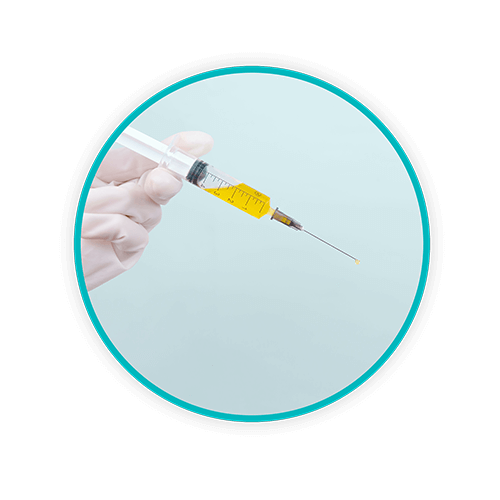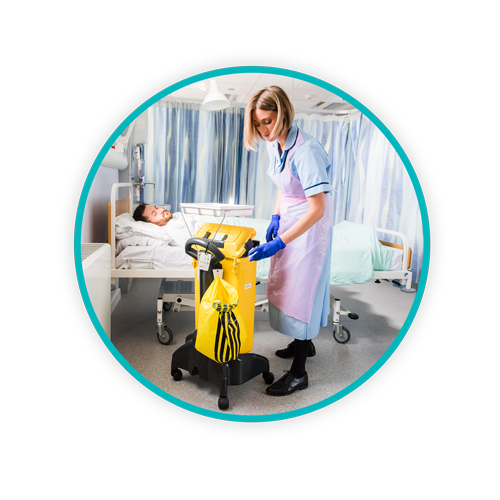The True Cost of a Needlestick Injury

Are you aware of the true cost of a needlestick injury? We’ll give you a clue… whilst the financial cost is part of it, there’s a huge emotional toll and human cost too.
Sharps safety isn’t a luxury, it’s a responsibility, and one that we must all take seriously. Every day, thousands of healthcare professionals across the UK face the risk of needlestick injuries (NSIs), often whilst performing routine tasks.
At Sharpsmart, we believe that understanding the true cost of a needlestick injury is essential to drive change. It’s not just about numbers, it’s about people, and making the right decisions to protect them.
TOPICS WE WILL COVER:
1 / The Financial Cost of a Needlestick Injury
2 / The Emotional Cost of a Needlestick Injury
4 / A Call to Action for Healthcare Leaders
5 / Why Safer Sharps Containment Matters
6 / Let’s Make Healthcare Safer, Together
The Financial Cost of a Needlestick Injury

The exposure risk of needlestick injuries is far greater than is commonly reported. While Aids, Hepatitis B, and Hepatitis C are amongst the more severe diseases that can be contracted via sharps penetration, there are in fact more than 60 bloodborne pathogens that can be contracted as a result of a sharps injury.
NHS Resolution’s 2023 Preventing Needlestick Injuries publication showed that between 2012 and 2022*, NHS Resolution received 2,600 claims related to NSIs, which are often costly to investigate. 1,947 claims were successful, resulting in a total payout of £10.8 million in damages and legal costs.
Interestingly, of the 1,947 successful claims received in that time period, only 432 came from clinical staff. The majority – 1,460 claims – were submitted by ancillary workers, including porters, cleaners, laundry staff, and maintenance teams. This highlights a critical truth: needlestick injuries affect everyone in the healthcare environment, not just those delivering direct patient care.
And these figures only reflect reported and litigated cases. Many more injuries go unreported, and the hidden costs – from lost time associated with side-effects and treatment to the resources required for investigations – are rarely captured in financial statements.
But even so, the financial cost is only a small part of it. It doesn’t account for the ‘harder to monetise’ human impact experienced by those affected. So what about the human cost of a needlestick injury?
*Fiscal years
The Emotional Cost of a Needlestick Injury
 There is no convenient time for a sharps injury to occur, and whilst the financial cost may be measurable, the emotional impact of an NSI is far more difficult to quantify – and often far more devastating.
There is no convenient time for a sharps injury to occur, and whilst the financial cost may be measurable, the emotional impact of an NSI is far more difficult to quantify – and often far more devastating.
When a needlestick injury occurs, there’s a natural disruption that follows. For the person who suffers an NSI, the experience doesn’t end with the injury. It begins a long and often distressing journey of uncertainty that in some cases involves undergoing months of blood testing to determine whether a serious bloodborne pathogen such as HIV, Hepatitis B or Hepatitis C has been contracted.
During this time, the injured person may be prescribed antiviral medications with severe side effects. They may be unable to work. They may also carry the emotional weight of not knowing whether their life has changed forever. Often, an individual in this situation will feel isolated, stigmatised, or even blamed for the incident – the process following an NSI can create an environment where the victim feels they have done something wrong.
A landmark study published in Occupational Medicine (Green & Griffiths, 2013) found that psychiatric illness following NSIs is both common and severe. Among the 17 patients studied, most were diagnosed with adjustment disorder (AD), and almost a quarter developed post-traumatic stress disorder (PTSD). None of the patients in the study contracted an infection, yet the psychological impact was significant.
There are also several other hidden human costs:
- The stigma attached to reporting a sharps injury.
- The stress and anxiety while waiting for test results, which sometimes take months to come through.
- The distressing side effects of antiviral drugs that cause suffering to both the victim and their families.
- The loss of time and labour to sickness as a result of the incident.
- The negative knock-on effect on family relationships.
As is evident, the human cost is far too high for an injury that, with the right equipment and processes in place, can be easily prevented.
Every Injury Has a Story

Something we must all remember about NSIs is that they are more than statistics or numbers. Behind every needlestick injury is a person – a nurse, a porter, a cleaner, a waste handler – who now faces a deeply personal challenge. Every injury incurs a significant consequence for the person exposed and their loved ones, especially if it was a high-risk exposure or the patient chooses not to consent to having their blood drawn.
‘For some, the injury is a wake-up call. For others, it’s a life-altering event.’
Numerous diseases can be contracted from a sharps injury – more than 60 bloodborne pathogens can be contracted as a result of an NSI – and in cases where a communicable disease is contracted, the consequences can be permanent. But as mentioned briefly earlier, even when no infection occurs, the psychological trauma can linger. The fear. The waiting. The ‘what ifs’. These are the costs that don’t appear in spreadsheets, but they are very real, especially for the person paying them.
A common narrative from needlestick injury survivors is that the time waiting for blood results is their most emotionally unsettling memory of being stuck. Beyond the pressure that they feel having left their team a staff member short, they are now in a state of psychological unrest, waiting to find out whether or not they have contracted a life-threatening illness.
And it’s not just the injured party who suffers. In incidents where one colleague accidentally injures another, the emotional burden can be shared. Guilt, anxiety, and distress ripple through teams, affecting morale and trust.
A Call to Action for Healthcare Leaders

As an industry and a group of people committed to improving safety for healthcare workers, it requires a collaborative effort to ensure that everyone – healthcare practitioners, portering staff, and patients – get home safely at the end of the day.
For procurement teams, clinical executives, health and safety managers, and all healthcare leaders, the message is clear: the cost of inaction is too high.
Eliminating sharps injuries relies on many factors – safer devices, safer sharps containers, leadership focus, and the adoption of safer processes. Investing in safer sharps containment isn’t just about compliance – it’s about compassion. It’s about recognising that every injury has a ripple effect, and that every step we take toward prevention is a step toward a safer, more supportive healthcare environment.
Why Safer Sharps Containment Matters
Needlestick injuries are preventable. But prevention requires more than policy alone. It requires investment in the right tools and systems.
At Sharpsmart, we don’t just supply containers – we actively partner with healthcare providers to make healthcare safer. We set the ISO standard with our safety-engineered reusable sharps containers – proven to reduce NSIs by up to 87%.
Our clinically engineered sharps containment solutions reduce NSIs via:
- Hand-restricted safety tray with zero container assembly required.
- Inbuilt overfill mechanism to close the tray once the safe fill level is reached.
- Temporary and permanent safety locks ensure a secure closure.
- Hands-free disposal and arriving pre-assembled as a single unit.
- Puncture-resistant design manufactured using ABS plastic.
Choosing the safest sharps containment isn’t just a procurement decision – it’s a clinical safety decision. It’s about protecting the people who care for others. It’s about reducing risk, improving outcomes, and creating a culture where safety is embedded in every decision and action.
Learn more about the world’s safest sharps containers.
Let’s Make Healthcare Safer, Together
At Sharpsmart, we’re proud to support healthcare providers across the UK in building safer, smarter systems that protect every member of the healthcare team.
Whether you’re looking for guidance and advice or a reliable sharps waste disposal service that prioritises safety, we’re here to help.
If you’d like to discover how we can help improve your sharps waste management, please don’t hesitate to get in touch.
Let's Talk!
Your time is valuable, and we don’t want to play hard to get. You can either phone us directly on the details listed on our contact page, or feel free to fill out this short form and one of our team members will get back to you as quickly as possible.
